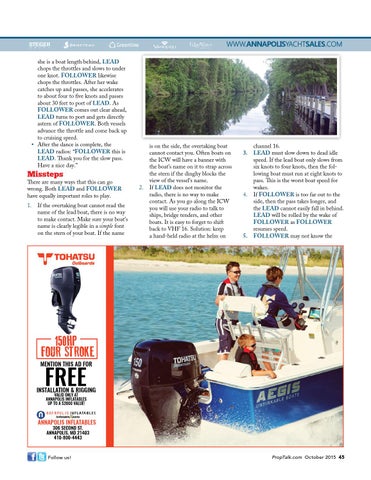WWW.ANNAPOLISYACHTSALES.COM she is a boat length behind, LEAD chops the throttles and slows to under one knot. FOLLOWER likewise chops the throttles. After her wake catches up and passes, she accelerates to about four to five knots and passes about 30 feet to port of LEAD. As FOLLOWER comes out clear ahead, LEAD turns to port and gets directly astern of FOLLOWER. Both vessels advance the throttle and come back up to cruising speed. •• After the dance is complete, the LEAD radios: “FOLLOWER this is LEAD. Thank you for the slow pass. Have a nice day.”
Missteps
There are many ways that this can go wrong. Both LEAD and FOLLOWER have equally important roles to play.
1. If the overtaking boat cannot read the name of the lead boat, there is no way to make contact. Make sure your boat’s name is clearly legible in a simple font on the stern of your boat. If the name
is on the side, the overtaking boat cannot contact you. Often boats on the ICW will have a banner with the boat’s name on it to strap across the stern if the dinghy blocks the view of the vessel’s name. 2. If LEAD does not monitor the radio, there is no way to make contact. As you go along the ICW you will use your radio to talk to ships, bridge tenders, and other boats. It is easy to forget to shift back to VHF 16. Solution: keep a hand-held radio at the helm on
channel 16. 3. LEAD must slow down to dead idle speed. If the lead boat only slows from six knots to four knots, then the following boat must run at eight knots to pass. This is the worst boat speed for wakes. 4. If FOLLOWER is too far out to the side, then the pass takes longer, and the LEAD cannot easily fall in behind. LEAD will be rolled by the wake of FOLLOWER as FOLLOWER resumes speed. 5. FOLLOWER may not know the
150HP FOUR STROKE
MENTION THIS AD FOR
FREE
INSTALLATION & RIGGING VALID ONLY AT ANNAPOLIS INFLATABLES UP TO A $2000 VALUE!
ANNAPOLIS INFLATABLES 306 SECOND ST. ANNAPOLIS, MD 21403 410-800-4443
Follow us!
PropTalk.com October 2015 45
